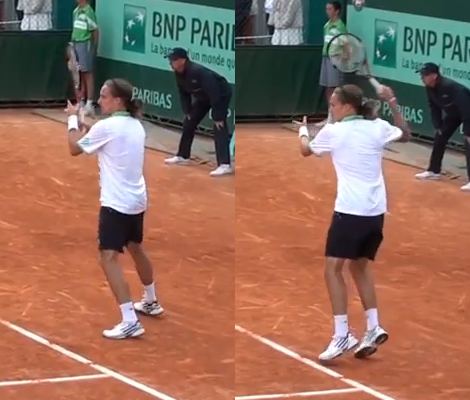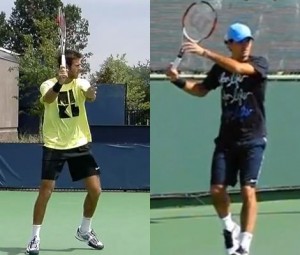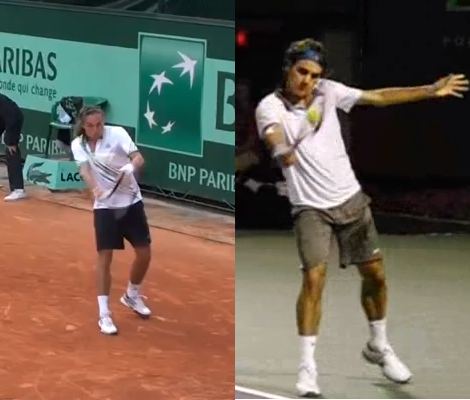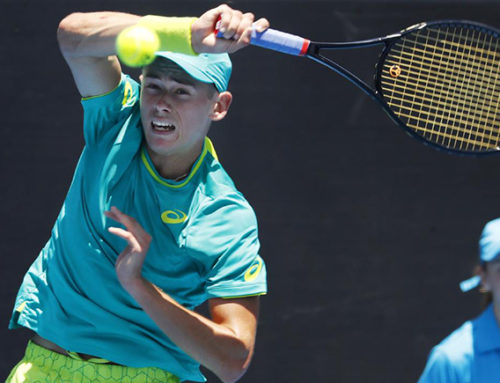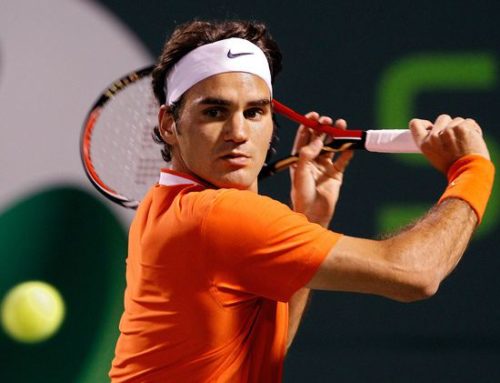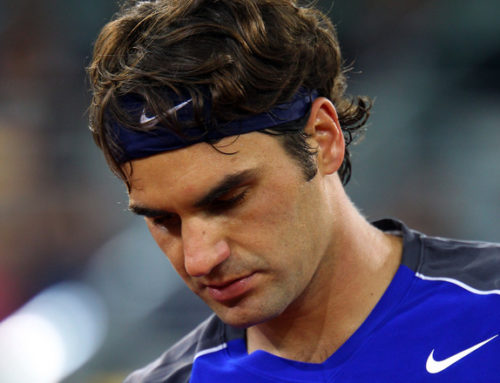Alexandr Dolgopolov is one of several names mentioned when tennis pundits across the globe talk about the ‘next generation’ – the group of players who are supposed to step up and take the mantle of the Federer, Nadal and Djokovic just as they have taken the mantle of the Sampras, Agassis etc who came before them. With his unusual playing style, Dolgopolov is a crowd favorite where-ever he plays and with good reason – he plays an entertaining brand of tennis that is rare at the top of today’s professional game. But at 24 years old, just one year shy of Djokovic with his five Grand Slam titles, does Dolgopolov really belong in the conversation of potential future greats? Or has he already reached the zenith of his tennis abilities, with nothing great to come? Today we will break down Dolgopolov’s game and take a look at what the future should hold for him.
Background
Alexandr Dolgopolov turned pro in 2006, having been coached from the age of 3 by his father Oleksander, a former ATP pro himself. Called Sasha by his family and friends, he has an altogether different nickname from his fellow players: “The Dog”. His rise has been steady if not meteoric – a gradual climb from Futures events to his current top-20 ranking. In spite of (or perhaps because of) his father’s incredibly strict, disciplinarian approach to the game, Dolgopolov is Fire to his father’s Earth. Hyper-aggressive, unorthodox, he strives for unpredictability in his shot-making. It should have been a surprise to nobody, therefore, when he split ways with his father in 2008 to find his own tennis path – much to his father’s chagrin. They have since reconciled, and under the tutelage of Australian coach Jack Reader he soared to a career high of 13 in February of 2012 before breaking that partnership at the end of last year. So what makes Dolgopov’s game tick?
The Serve
Any conversation of Alexandr’s game must begin with perhaps his most distinctive stroke – his serve. Even those unfamiliar with tennis take notice of his unusual delivery as it stands out as being markedly different from those of his peers. It is a very rapid, hurried motion. Whereas most player’s service motions have a measured rhythm to them, Dolgopov seems almost in a rush to make contact with the ball.
As you can see in the video above, Alexandr makes contact with the ball at the very peak of his ball toss. A typical server will toss the ball inches to sometimes a couple of feet higher than the desired contact point. They use the extra time to put all the physical pieces of their motion in place – racket into the trophy position, appropriate positioning of the shoulders, and the knee bend to allow them to drive up into the acceleration phase of the service motion. Dolgopov instead crams all of these things into a significantly shorter period of time, giving him the extremely rapid-fire delivery that you see.
It does have its advantages however. Returners often put together between one and perhaps a dozen medium-to-miniscule visual cues to help them anticipate the direction of the incoming serve. The position of the ball toss, the alignment of the hips, shoulders, position of the hitting arm, the angle of the serve’s body… many times even after correctly guessing where the serve was going to go most players couldn’t verbally explain why. Malcolm Gladwell wrote an entire book about the phenomenon called Blink: The Power of Thinking Without Thinking. The beauty of Dolgopolov’s extremely rapid service motion is it significantly compresses the time for the returner’s brain to both catch and then calculate the impact of those tiny details. By hitting the ball so early in the toss small variations in toss location are better disguised. Dolgopolov goes through his load-and-explode phase so quickly that the orientation of his shoulders and hips are much harder to discern. Everything happens in the blink of an eye.
A second aspect is that returners have a rhythm of their own. Watch Federer hit a return, and his routine is the same. He starts with a wide base, strong bend at the hips. Then when the ball is tossed, he takes a single step forward, hops from there into a split-step with both feet and then reacts to the serve. Dolgopolov’s service rhythm is so fast and unusual, that it throws returners out of their normal routines. It might seem a small thing, but the timing of the split-step is critical in the return. The ballistic loading must occur at the right instant in order to get maximum explosion out of the first step. Pausing for even a couple hundredths of a second at the bottom of the split second is fatal, as is not being able to complete the split-step motion to begin with. Most pros will adapt over the course of the match, but it is something that takes adapting to – giving Dolgopolov an early advantage on his own serve.
As far as the outcome, Doglopolov’s delivery is a mixed bag. The velocity on his flat serve tops out a touch under 140 mph – obviously some significant speed. However given his height is either 5’11 or 6’0 (depending on which source you believe), it should be no surprise that his first serve % typically sits around 55% and on bad days can drop down into the 40’s and even high 30’s. His average first serve speed sits at 116 mph in most of his matches, with his second serve coming in around 90 mph on average. He is capable of good lateral movement on the serve, effectively sliding it from his right to his left with slice.
His directional stats are consistent to the point of bordering on predictable. On the deuce court he serves roughly 85% of his first serves either out wide or at the body, and some matches as high as 60-70% of them can be the wide one. On the ad side his serves are much more evenly spread, and the variation from match to match suggests he makes small adjustments on that side depending on his opponent. His second serve goes almost exclusively down the middle of the box at his opponent’s body. In fact his service patterns very closely mirror those of Roger Federer, perhaps with the same goal of earning a forehand as his first shot of the rally. Which brings us to…
Groundstrokes
Dolgopolov’s forehand is almost as distinctive as his serve. However in this case many aspects of this distinctiveness are more cosmetic than they are ‘real’. To begin with let’s take a quick glance at the preparation phase of his forehand:
Although the differences in the image above are small, they create a significant visual appearance when he hits the stroke at full speed. In the left image, we can see Dolgopolov has initiated his shoulder turn and begun to take his racket back with the racket in essentially a vertical position. This is a preparation position typically associated with a flatter ball at contact, in the vein of Del Potro where the wrist is not as mobile and the angle of attack on the ball a little shallower. The second position however, with the racket leaning towards the net is more along the lines of a Federer-style forehand with higher wrist mobility and a fuller, deeper backswing. Typically with the latter, the racket lean is initiated from the beginning of the stroke.
This ‘switch’ to the lean later in the preparation phase gives Dolgopolov’s forehand a more complex preparation than is necessary and makes his transition from preparation to acceleration less smooth than say, Federer. This makes his timing a little more precarious than it needs to be. He has great variety on the shot itself – he is capable of hitting the ball both with reasonably heavy spin and very flat with pace. He exhibits a range of finishing positions, from a Federer-like across-the-body ‘windshield wiper’ finish to the occasional Nadal-like ‘buggy whip’ finish over the head. He can and will also utilize a slice forehand to good effect.
Dolgopov’s backhand is technically a very solid shot – both more steady and less varied than his forehand. It is a pendulum-type swing, compact in both take-back and follow through and is very reminiscent of Marat Safin in the way he bends both arms up in the follow-through phase. He hits a relatively flat ball off this side, and is certainly capable of hurting opponents with this shot. His slice backhand is very respectable and a shot he uses frequently both in defense and for change of pace. Interestingly Dolgopov often opens his shoulders on the slice relatively early compared to a classic one-handed slice backhand. Doing so can add a stronger side-spin component to it giving the ball more lateral movement which some players find difficult to handle. If you look carefully at the image below you can see the different alignment of Dolgopolov’s shoulders relative to the net in comparison to Federer at contact.
Volleys
Not surprisingly Dolgopolov has good hands at the net. He has had some doubles success, winning the Masters event at Indian Wells with Xavier Malisse in 2011. His volleys are reasonably compact and crisp, but there is one small technical thing worth noting. He holds a relatively ‘strong’ continental grip for his volleys (biased slightly towards an eastern backhand grip). While this provides a strong wrist position on the backhand volley (and his backhand volley is very classic in style), it does force him into a slightly late contact point on the forehand side. As such his forehand volley is technically a weaker shot than his backhand volley, and he is susceptible to being jammed on that side.
Tactics/Mental
Oftentimes we separate out the mental side of the game from the tactical, but with Dolgopolov this is very difficult to do because his tactics are dictated in many aspects by his mental state. That isn’t to suggest his tactics change depending on his mood – he is a fairly even-keeled competitor who doesn’t become unduly upset over minor (or even major) things during his matches. However he is an adventurous spirit on the court and that does dictate his tactics and shot-making decisions to a large degree. Nobody doubts Dolgopolov’s shot-making ability. He is a wizard with a racket – but as with some wizards in the past (such as Marcelo Rios) he at times seems more intent on creating magic than winning tennis matches.
He once said, “I try to play unpredictable, and make my opponents uncomfortable.” However Dolgopolov is often unpredictable to a fault – in his driving need to play different he is often driven to playing the wrong shot for the situation. Andy Roddick once said after playing him: “I knew that he was aggressive to the point of psychosis”. The problem for Dolgopolov is that the margins at the top of the game are so small – it is not just how many unforced errors you hit in your match, but when you hit them that is important. If tennis were poker, the great players have that intuitive sense of the odds – they know their hand well and how much to bet on that hand. Dolgopolov is instead that poker player who places his bets sometimes without even looking at the cards – the thrill of the gamble means as much if not more to him than the thrill of victory.
The Future
And so we arrive at the central question: has Dolgopolov peaked at age 24 as a ‘top 20 player’? The answer to that, in truth, is ‘it depends’. It is well understood that, in general, attacking players tend to mature later in their careers. However at age 24 Dolgopolov must surely be approaching his peak. He showed consistent and steady improvements in his ranking up until the end of 2011 – since then he has bounced between 13 and 20 with no sign of breaking through to that next level. Dolgopolov has had enough to time to learn his craft – the question now becomes whether or not he has the mental fortitude and desire to set aside those things that are holding him back. Is he preparing physically for each season the way that he should? We have seen time and again players who have committed themselves fully to their strength and conditioning and had their big breakthrough as a result (Mardy Fish, Fernando Verdasco, Lindsey Davenport… the list is extensive). Given he suffers from the hereditary disorder Gilbert’s Syndrome he may simply not be able to get in the peak physical condition required. Is he willing to tighten up his play with a more disciplined approach, playing a higher percentage brand of tennis?
He must find the correct trade-offs in order to maximize his chances of stringing together wins. For example Dolgopolov ranked 9th on the tour last season on 1st Serve % won with 75% (to give this perspective, Federer won 78%). However Dolgopolov ranked a paltry 47th in First Serve % at 54% (again in comparison Federer was 18th at 63%). Would Dolgopolov be better served by taking a little off more of his first serves and bringing his first serve percentage up? It would seem it would be worth losing a slightly higher percentage of his first serve points in order to do so. Whatever compromises Dolgopolov makes, it is clear that he must make some. He is talented enough that his daredevil play-style has brought him into the top 20. To go further however, he must place his unpredictability inside some structure. He must create patterns in order to break them. Whether or not he is willing to do that will decide whether he finishes this year inside the top 10, or risks ending it outside the top 20. He has talent, but there are plenty of other players with talent who are willing to grind out the result when needed and are more than happy to take his place if he should stumble.
